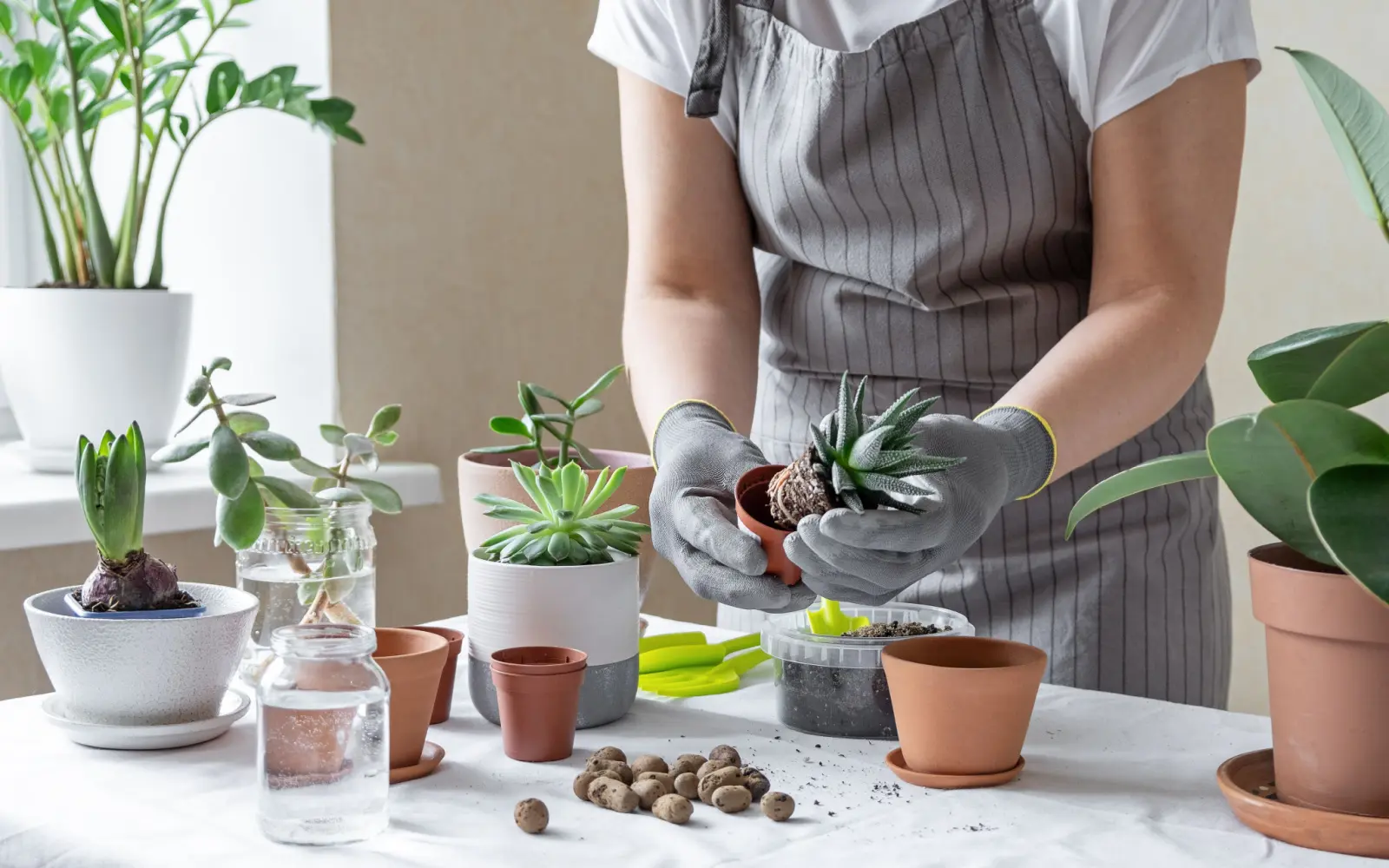Cacti or cactuses (both are correct) are excellent plants to have in your home to add interest and beauty to any space.
Most cacti also do well outdoors as long as they’re planted in an ideal area in your yard.
Let’s talk about the six most popular types of cacti.
Types of Cacti: A Summary
There are numerous cacti species, including:
- Ball cacti
- Bunny Ear Cacti
- Torch Cacti
Choosing cacti for your home is fun, and these plants are easy to care for.
The 6 Best Type of Cacti to Grow
Adding cacti to your home and garden is a great way to make the most of your space. These plants are beautiful and easy to care for, as long as you don’t overwater them.
1. Pincushion Cactus
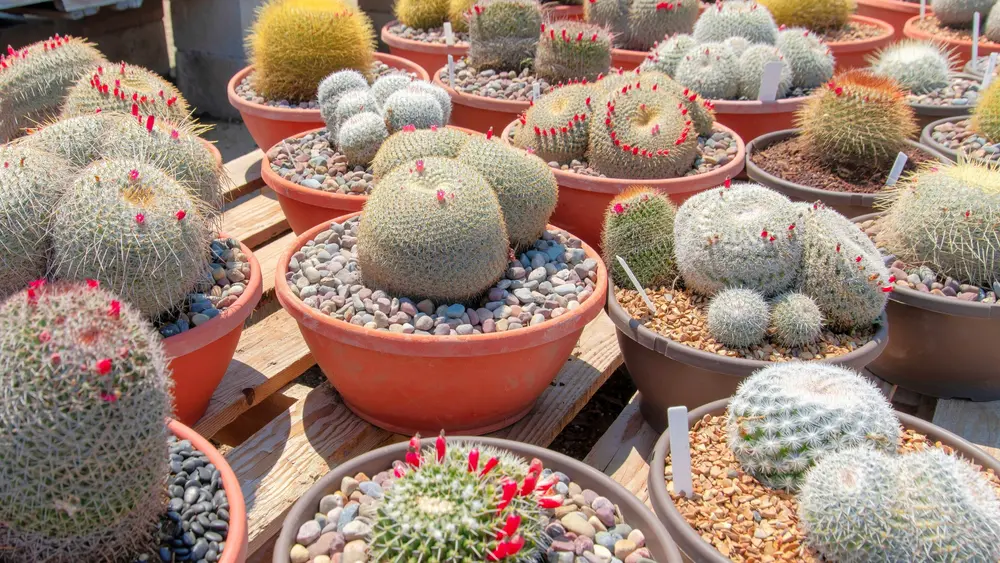
Jason Finn/Shutterstock
The pincushion cactus is one of the most common cacti found in any supermarket garden section.
The pincushion cactus is a common name that covers about 200 different species of the cactus family Mammillaria, which means “nipple” or “areola.”
This somewhat unfortunate classification is thanks to Linnaeus and Austrian botanists. The reason for the moniker is that small flowers grow in a crown atop the rounded head of the cactus.
Pincushion cacti are native to Mexico, but some originate in the southwestern United States.
They are squat, rounded, or barrel-shaped and are covered with a thick layer of tiny spines closely clustered together.
The pincushion cactus flowers in the early summer. Its flowers are bright fuchsia, but they can also be white, yellow, or red.
2. Bunny Ear Cactus
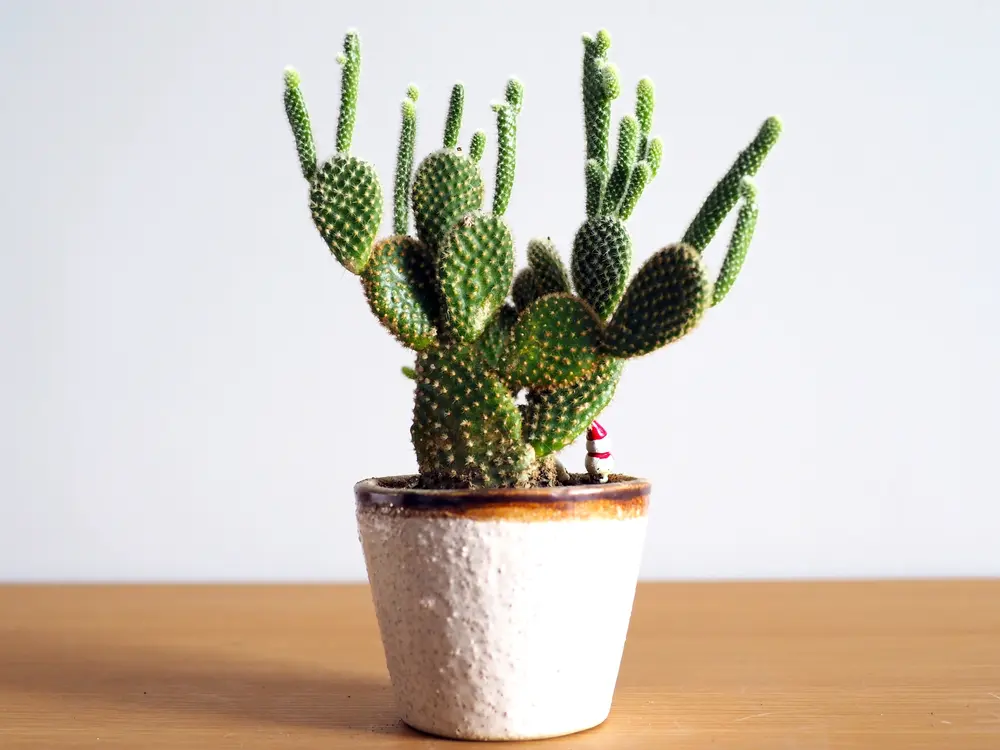
Benjavisa Ruangvaree Art/Shutterstock
These cuties are popular for their ease of care, resilience, and adorable appearance. As their name would suggest, bunny ear cacti resemble the ears of our lagomorph friends.
Their stems are flat and shaped like upside-down teardrops or the ears of a rabbit. These cacti can reach almost two feet tall if you let them, but if you plant them in a pot indoors, they likely won’t get that large.
Although the bunny ear cactus is native to northern Mexico, it has found great success in Kenya and Tanzania as a fog collector. Its tiny and well-dispersed spines do well at collecting fog, which helps visibility and can also be used to create drinking water.
The bunny ear cactus is called the angel’s wings cactus and the polka dot cactus (as its spine clusters resemble polka dots along the pad-like stems). Its Latin species name, microdasys, humorously (and accurately) means “small and hairy.”
If you’d like to grow a bunny ear cactus at home, they are happy in a pot with well-draining soil, preferably a sand-and-perlite mix. You likely won’t see your bunny ear cactus flower very often, but sometimes yellow blooms will pop up on top of the stems.
3. Torch Cactus
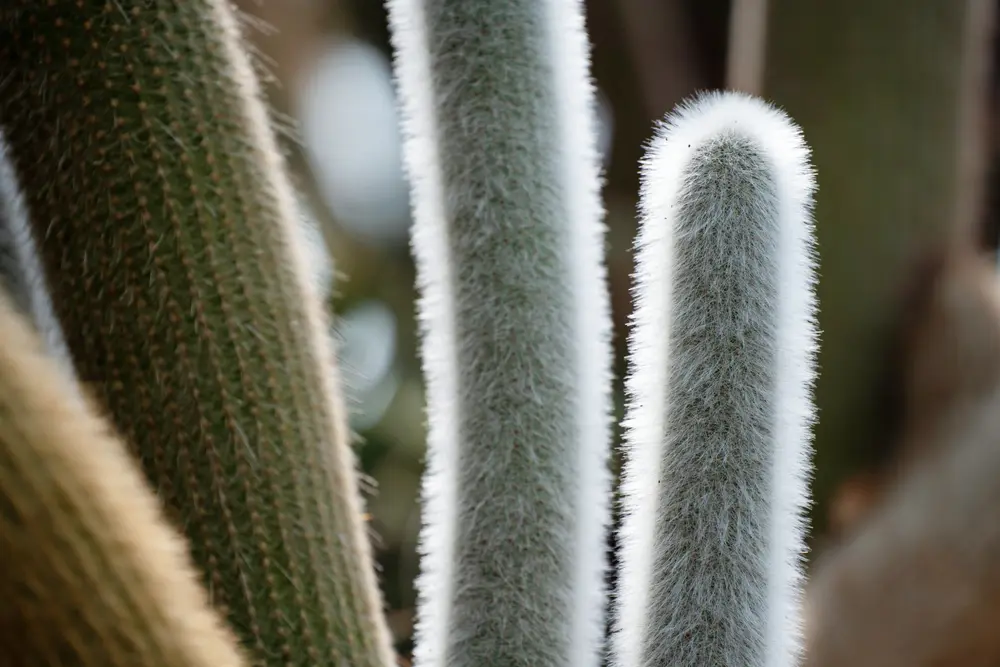
mokjc/Shutterstock
The torch cactus refers to several varieties of columnar cacti. A columnar cactus is a type of cactus that grows vertically (not ball- or barrel-shaped) and has ridges that travel vertically up the stem.
Some rare and wild varieties of torch cacti found in Bolivia and Peru can reach heights of up to six feet. The most popular cultivars (breeds and specially cultivated hybrids) in the US only grow to about two feet tall.
The most popular torch cactus to grow at home is the Trichocereus grandiflora, whose Latin name essentially translates to “hairy torch with large flowers.” This is true for these cacti!
Sometimes the flower colorations vary, and these cacti can have yellow or white flowers, but most commonly, the flowers are a brilliant red.
Unlike other types of cacti, which may only flower for several days, Trichocereus grandiflora blooms for the whole summer.
Another feature different from other cacti is that the torch cactus flourishes in partial sunlight. If you plant it outside, it needs a shady tree to reach its full potential and bloom in the summer.
If you keep it indoors, you can keep its pot in a room without direct sunlight, perhaps in a corner or behind thin curtains. Like other cacti, the torch cactus enjoys well-draining soil, but for this one, a bit of added potting soil would help retain moisture.
During spring and summer, be sure to water the cactus twice a month at least, but you can lessen that to once a month when the plant goes dormant in the fall and winter.
4. Ball Cactus
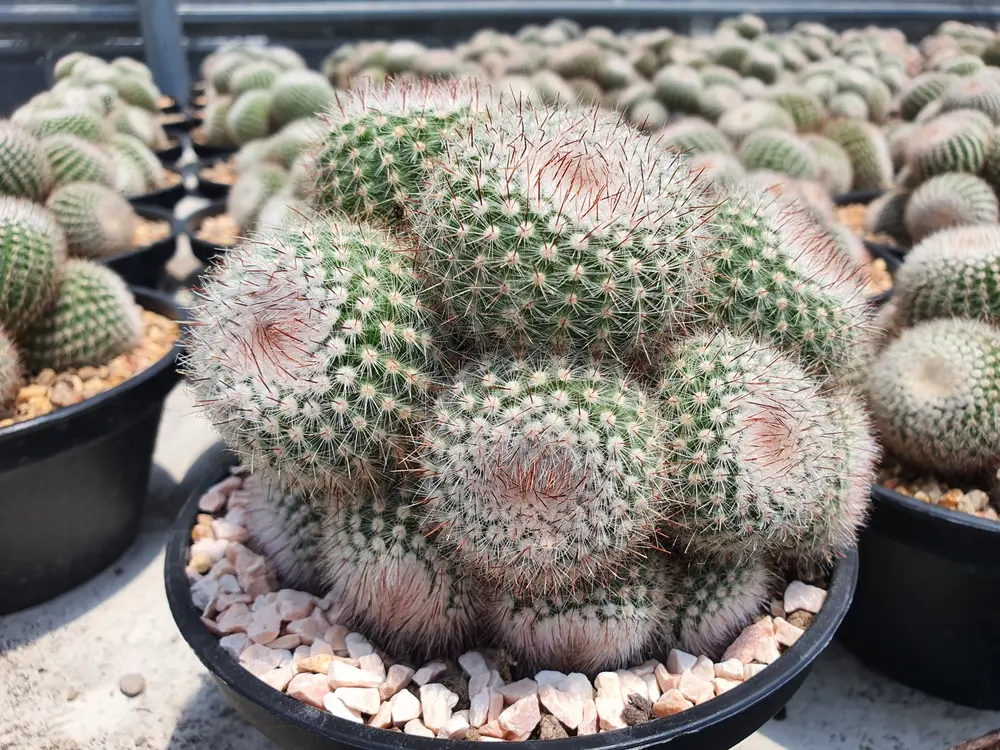
Pingky_p/Shutterstock
As its name would suggest, the ball cactus is almost spherical. Ball cacti only reach four to six inches high, making them perfect indoor cacti.
But if you can manage to keep growing your ball cactus year after year, you might be surprised to see it reach a height of an entire foot one day!
Like the torch cactus, ball cacti do best when they receive only a few hours a day of direct sunlight. They love the sun, but it needs to be partially diluted by a curtain, a shade tree, or just by being in an area of your home that doesn’t get full sunlight.
These round, radially symmetrical members of the Parodia family come in a few dozen different species, which means that each type can produce various colored flowers.
Ball cacti can grow yellow, pink, red, or orange flowers — you have to wait until summer to see what color flowers your little ball cactus will produce.
Sometimes, the large flower a ball cactus produces can be so large that it overtakes the actual cactus! As for watering your ball cactus, another similarity they have with torch cacti is that they need soil that does retain some moisture.
So rather than making them a potting mix with sand or gravel, try making one with some potting soil, a bit of gravel or perlite, and some loam.
This mix should retain enough moisture to keep them happy. Be sure to water your ball cactus at least twice a month in the summer and spring.
5. Hedgehog Cactus
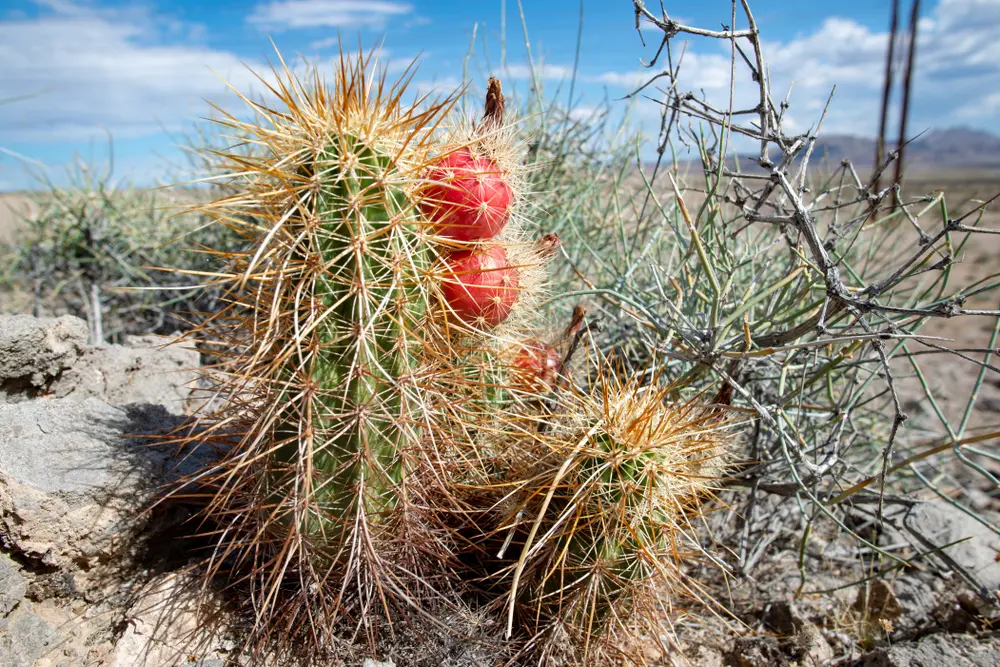
Dominic Gentilcore PhD/Shutterstock
The hedgehog cactus, or Echinocereus, is a common name for about six dozen cacti species native to the southern United States and Mexico. Their Latin name is a mixture of the Latin words for “hedgehog” and “candle” or “torch.”
This little cylindrical cactus does indeed resemble a hedgehog with a flower on its head. Some species produce edible fruits, but this is more common in the wild or in commercial cultivation than in your living room.
These beauties are covered in a thick layer of spine clusters that can range from only a quarter of an inch long to about an inch long.
Hedgehog cacti are hardy succulents, and they can withstand extreme cold or hot temperatures, hence their success in desert climates.
This also makes them easy to grow, even for an inexperienced cactus parent. Hedgehog cacti usually bloom in the spring, but they can also flower unpredictably.
They bloom once a year for about a week, with the flowers opening during the day and closing again at night. Their flowers can be pink, white, yellow, yellowish-green, or magenta.
Typical sandy, well-draining soil like most cacti enjoy is perfect for the hedgehog cactus, and you should water them about once every two weeks. You can taper off in the winter and fall to once a month. Make sure your hedgehog cactus receives plenty of sunlight.
6. Saguaro Cactus

Brent Coulter/Shutterstock
This gorgeous towering cactus is famous for its appearance all over the Southwestern States. In the deserts, this cactus is home to many types of desert wildlife, not least of which is the ridiculously adorable elf owl.
However, should you choose to take home a saguaro, you typically don’t have to worry about this columnar cactus reaching its in-the-wild height of 40 feet.
If you plant your saguaro cactus outdoors in full sunlight, it may reach that height if you care for it year after year. If you keep your saguaro cactus in a pot indoors, it will likely reach at least three or four feet after a while, especially if you purchase it as a baby cactus.
Saguaro cacti are not only gorgeous and majestic, but they are also deeply important to Mexican and American cultures and histories.
The white saguaro flower is the state flower of Arizona. These cacti have a life expectancy longer than humans; if you see a saguaro with side arms, it’s likely they’re at least 75 years old, perhaps even 100.
Your saguaro cactus needs full sunlight to thrive, and it also likes typical sandy cactus soil. You can fertilize it once a year if you choose, but this isn’t necessary.
If you live in a place where temperatures drop dramatically but you want to grow your saguaro cactus outside, it’s best to keep it in a pot so that if outdoor temperatures get too cold, you can bring it indoors.
You need to water it about once a month and let the soil dry out completely between each watering.
Frequently Asked Questions
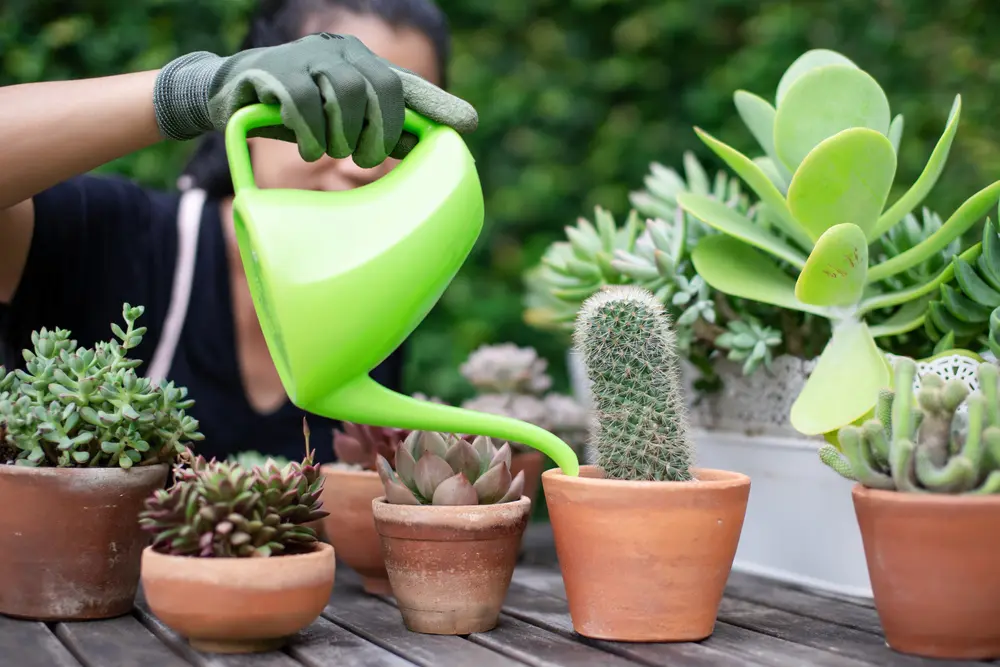
Sattahipbeach/Shutterstock
Below are the most frequently asked questions about different types of cacti.
What is the difference between a succulent and a cactus?
Cacti are a type of succulent plant. Cacti have spines and they store water in their stems. Succulents do not have spines and they store water in their thick, squishy leaves.
How many species of cacti are there?
Within the Cactaceae family, there are 127 genera (plural of genus) comprising more than 1750 individual species of cacti.
How long do indoor cacti live?
You can expect to get a decade out of your indoor cactus. In the wild, cacti can live for centuries. The wear and tear of being messed with and repotted stay with your home-dwelling cactus, and these blemishes show for the rest of their lives. Indoor life can be difficult for your little potted friend.
What are some common cactus pests to look out for?
When it comes to your indoor cacti, be aware of spider mites, mealybugs, and aphids. Also, make sure root rot doesn’t occur by keeping your cactus’s soil well-drained.
What is the best soil for cactuses?
If your cactus, like most succulents, requires well-draining soil, the best potting mixture you can use is a sandy potting mixture.
You can also place gravel intermittently throughout the pot and even a layer of loam to aid with drainage.
Many cacti potting mixes include perlite, a volcanic glass that can be mixed with sand and loam to keep the soil well-draining and your cactus happy.
Which Type of Cacti Is Right for You?
Cacti can make excellent houseplants, and these six we discussed above are wonderful additions to your home, whether they’re the first plants you’ve ever had or you’re an experienced botanist.
As long as you pay attention to the needs of your spiny succulents and stay aware of potential pests and seasonal changes, these cacti should thrive in your home or yard.

